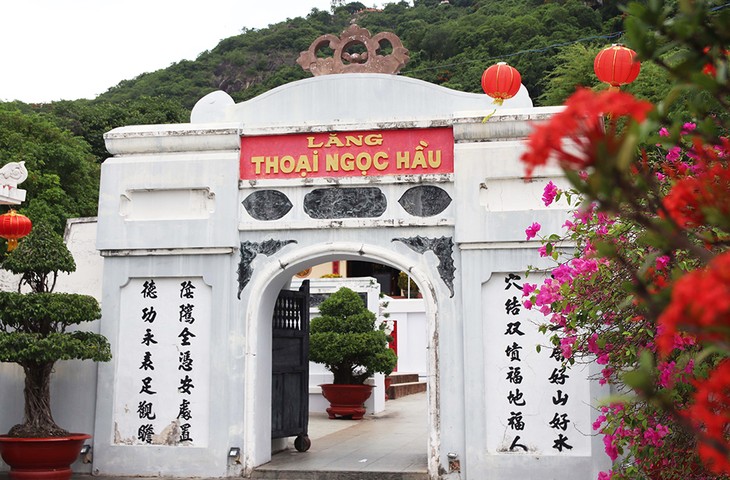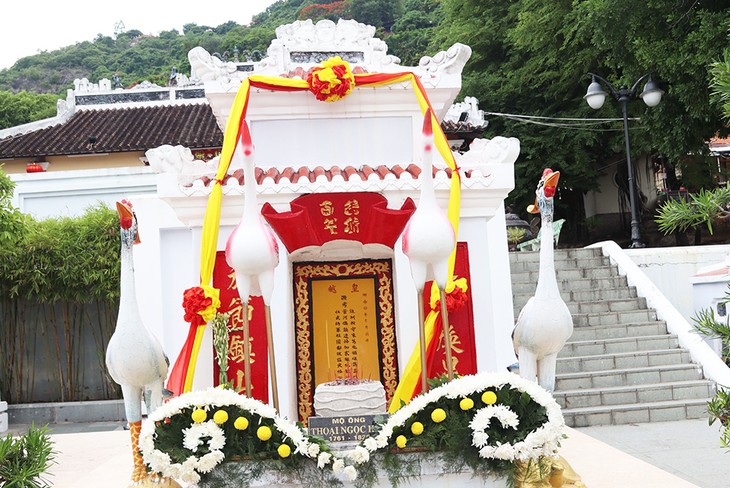(VOVWORLD) - Built at the foot of Sam Mountain in Chau Doc city, An Giang province, Thoai Ngoc Hau Mausoleum, also known as Son Lang (mountain tomb), has an architecture typical of the Nguyen Dynasty (1802‑1945). This is the resting place of Thoai Ngoc Hau, a prominent general of the Nguyen Dynasty.
 Thoai Ngoc Hau Mausoleum in Chau Doc city, An Giang province (photo: baoangiang.com.vn) Thoai Ngoc Hau Mausoleum in Chau Doc city, An Giang province (photo: baoangiang.com.vn) |
Thoai Ngoc Hau, whose real name is Nguyen Van Thoai, was born in 1761 and died in 1829. From his home village in Dien Phuoc district, Quang Nam province, now Son Tra district, Da Nang city, he followed his family to resettle in the southern province of Vinh Long. His greatest merit was helping people dig Vinh Te and Thoai Ha canals, the two most important irrigation works created during the Nguyen Dynasty.
Tran Minh Trang, tour guide of the Sam Mountain Tourist Area Management Board, said: “Nguyen Lord conferred the title Hau (marquis) on him, so the people called him Thoai Ngoc Hau or the Protector Thoai because he accompanied the King on his journey to Thailand many times. He was appointed governor of Vinh Thanh by Lord Nguyen. He made many contributions to the nation such as reclaiming land, building roads, digging canals, while protecting and developing the southwest border.”
Thoai Ngoc Hau himself directed the building of his mausoleum in the 1820s. The mausoleum, which has both the tomb and temple, faces Ba Chua Xu temple to the north and leans against the back of Sam Mountain. The majestic construction has great cultural, historical, and architectural value. Looking from afar, on the side of Sam Mountain next to Vinh Te Canal, the impressively solemn mausoleum stands high surrounded by perennial trees.
The mausoleum is a harmonious architectural structure. It’s surrounded by thick, sturdy walls cast higher than a person’s head. In the front are two large semicircular gates, the architectural style of ancient mausoleums. The front yard is where a replica of the Thoai Son Stele is placed.
Tour guide Tran Minh Trang said: “Sam Mountain behind the mausoleum is like a protective shield. In front of the mausoleum are a vast, peaceful field and village. The construction exists harmoniously between humans and nature. Thoai Ngoc Hau ordered his men to transport laterite from Dong Nai province to Sam Mountain to build the mausoleum. The place where the boats docked to unload the laterite bricks is called Vaa Port.”
 The tomb Thoai Ngoc Hau (photo: baoangiang.com.vn) The tomb Thoai Ngoc Hau (photo: baoangiang.com.vn) |
Thoai Ngoc Hau’s tomb is located in the middle of the mausoleum. Trang introduced: “On the right is the tomb of his first wife Chau Thi Te and on the left is the smaller tomb of his second wife Truong Thi Miet. There are also graves of his courtiers and relatives. Every year people hold rituals to commemorate the death anniversaries of Thoai Ngoc Hau and his two wives.”
Majestic Thoai Ngoc Hau Temple leans against Sam Mountain. In the middle of the temple is a 2‑meter high bust of the general dressed in a full set of costumes as when he was a mandarin. He looks out over Vinh Te Canal in a very solemn manner. The temple has countless valuable adornments, such as ancient horizontal panels, parallel sentences, epitaphs, and poems praising the merits of the predecessors for expanding and protecting the territory.
Tran Trung Thanh, a Khmer man in An Giang province, told VOV: “The legendary mandarin Thoai Ngoc Hau was a foresighted person. The contemporary generation greatly appreciates his vision and merit to reclaim land. We, his descendants, will always protect and develop our land.”
Thoai Ngoc Hau Mausoleum was recognized as a National Relic in 1980.